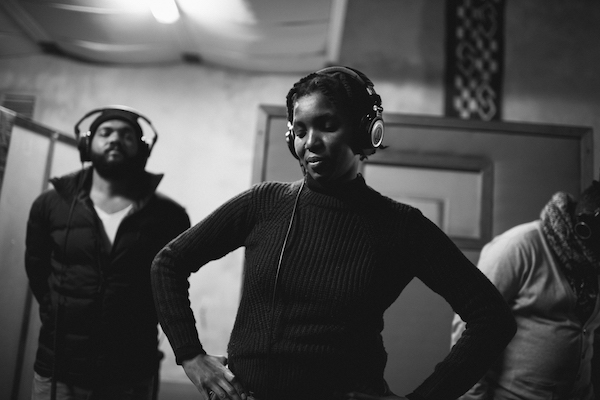Jun 3, 2025 11:25 AM
In Memoriam: Al Foster, 1943–2025
Al Foster, a drummer regarded for his fluency across the bebop, post-bop and funk/fusion lineages of jazz, died May 28…

Thandi Ntuli sought for Indaba Is to reflect cosmopolitan elements that pulsate through the scene in South Africa.
(Photo: Tseliso Monaheng)Indaba Is, a compilation recorded during June and July of 2020, ranks as a compelling document of the electrifying scene that emanates from Johannesburg, South Africa.
Pianist Thandi Ntuli and vocalist Siyabonga Mthembu, the album’s curators, both lament that the verve of South African jazz sometimes gets lost in translation on foreign stages.
Mthembu, speaking with DownBeat from South Africa in January, said that some unfamiliar audiences occasionally exclaim, “Oh, my God, you guys are so crazy. You’re so out there.” But in context, their idiosyncratic flavor “has a meaning. It has a purpose.”
The compilation is as much a declaration of that context as it is an affirmation of their unique perspective, according to Ntuli. She hopes Indaba Is serves as “an affirmation of ourselves, as well, because part of our own personal liberation has also included affirming the worthiness of the African perspective.”
Mthembu performs as a member of Shabaka and the Ancestors. The band, sans namesake reedist Shabaka Hutchings, contributed “Prelude To Writing Together” to Indaba Is. But he traces the impetus of the album back to a gig the ensemble played at New York’s Winter Jazzfest in 2017.
“The morning afterwards, I got a long message from a journalist who said, ‘I had watched Hugh Masekela 30 years ago in the same room,’” Mthembu said. “I remembered what a global force South Africa was in the jazz space and in the Black music space.”
Mthembu also began to recognize a continuity between the music he and his peers were creating, and the music that his parents listened to while he was growing up.
Not long afterward, while at dinner following a London gig, Mthembu heard “Abusey Junction” by Kokoroko from We Out Here, a 2018 Brownswood compilation built around London’s burgeoning jazz scene. He’d been “in and around that London scene,” taking in its energy. But the vocalist was well aware that there were other idiosyncratic enclaves developing across the world.
Mthembu thought that a similar recording could be centered on Johannesburg’s scene. Ntuli was then brought in as co-curator.
She framed the initial challenge: “How do we tell such a large story with eight tracks on an album?”
The pair ultimately concluded that the recording should be “less about individual artists and more about the backstory of where we all come from and the scene at large,” Ntuli said.
That scene encompasses a spate of acts, including pianist Bokani Dyer and avant-garde band The Wretched. To Ntuli, it was important that the album reflect the cosmopolitan elements that pulsate through the scene.
“The nature of Johannesburg is that historically, it’s a migrant city, built around the gold rush booming [in South Africa],” Ntuli said. “And those influences have been in our music for years. Our generation is continuing that legacy.”
It was crucial to both Mthembu and Ntuli that the recording declare the South African perspective, ideologically and aesthetically. “The Bantu cosmology exists, we have stories of our beginnings,” Mthembu explained. “Even the title Indaba Is is pointing to Indaba, My Children, which is Sanusi Credo Mutwa’s book about the beginning of the Bantu people. We’re affirming it.”
In indigenous South African culture, music isn’t a commodity to be purchased, Mthembu said: “The arts [are] really central to our healing. They’re not just something to be put on SoundCloud to stream for life immemorial.”
The vocalist is particularly mindful to recognize his elders, who he considers “important to our building blocks in South African music.” He name-checked Madala Kunene, “the father of Zulu guitar,” and Busi Mhlongo, “the mother of guitar,” whose 2009 album, Amakholwa=Believers, “is probably the biggest healing balm to this time,” he said.
Ntuli concluded that she sees Indaba Is as a turning point for her generation, an assertion “of ancient, traditional knowledge systems that are based [in South Africa] that we have always maybe sensed, but were not allowed to be a part of our culture.” DB

Foster was truly a drummer to the stars, including Miles Davis, Sonny Rollins and Joe Henderson.
Jun 3, 2025 11:25 AM
Al Foster, a drummer regarded for his fluency across the bebop, post-bop and funk/fusion lineages of jazz, died May 28…

“Branford’s playing has steadily improved,” says younger brother Wynton Marsalis. “He’s just gotten more and more serious.”
May 20, 2025 11:58 AM
Branford Marsalis was on the road again. Coffee cup in hand, the saxophonist — sporting a gray hoodie and a look of…

“What did I want more of when I was this age?” Sasha Berliner asks when she’s in her teaching mode.
May 13, 2025 12:39 PM
Part of the jazz vibraphone conversation since her late teens, Sasha Berliner has long come across as a fully formed…

Roscoe Mitchell will receive a Lifetime Achievement award at this year’s Vision Festival.
May 27, 2025 6:21 PM
Arts for Art has announced the full lineup for the 2025 Vision Festival, which will run June 2–7 at Roulette…

Benny Benack III and his quartet took the Midwest Jazz Collective’s route for a test run this spring.
Jun 3, 2025 10:31 AM
The time and labor required to tour is, for many musicians, daunting at best and prohibitive at worst. It’s hardly…